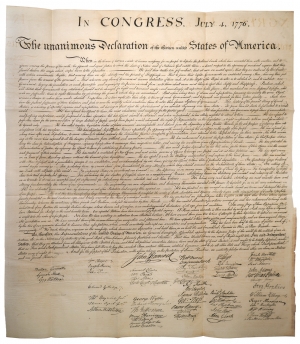|
A Stone/Force Printing of the Declaration of Independence (SOLD) |
Click to enlarge:

“In Congress, July 4th 1776. The Unanimous Declaration
of the thirteen united States of America...”
DECLARATION OF INDEPENDENCE.
Copperplate engraving printed on thin wove paper. Imprint at bottom left, “W. J. STONE SC WASHn” [William J. Stone for Peter Force, Washington, D.C. ca. 1833]. Printed for Peter Force’s
American Archives, Series 5, Vol I. Approx. 25 x 30 in.
Inventory #26238
SOLD — please inquire about other items
By 1820 the original Declaration of Independence, now housed at the National Archives in Washington, D.C., already showed signs of age and wear from handling. John Quincy Adams, then Secretary of State, commissioned William J. Stone to engrave a facsimile – an exact copy –on a copper plate. There is still debate about whether Stone used a “wet” or chemical process to trace the original manuscript, helping to make the exact copy. We have found differences that lead us to believe that he did not, but in any case, he expertly engraved it by hand over a long period of time. When he was done, in 1823, Congress ordered 200 official copies printed on vellum, which were distributed by act of Congress via John Quincy Adams.
The “Force” printing is the second Stone edition. Most descriptions date the “Force” to 1848, consistent with the publication of Peter Force’s American Archives: A Documentary History of the United States of America, Series V, Volume I, which included the Declaration facsimile.
However, we found that Force had already procured the Declaration facsimiles 15 years earlier, when Congress authorized the American Archives project, and the State Department signed a contract for 1,500 copies. On July 21, 1833, the original engraver, William Stone, invoiced Force for 4,000 imprints of the Declaration. Perhaps Force thought he would sell as many as 2,500 additional copies of his series by subscription. After mounting expenses and increasing delays in producing Series IV, by 1843, when Force received Congressional re-authorization, he had scaled back his subscription plan to 500 copies. But the documents had long been printed.
Very little of the original engrossed manuscript of the Declaration is legible today, after its nearly complete deterioration. The very rare Stone first edition, and this Stone/Force second edition, remain the best representations of the Declaration as the manuscript originally looked.